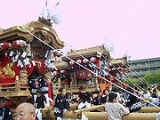
Danjiri Matsuri
Encyclopedia
Danjiri Matsuri are cart-pulling festivals held in Japan
. The Kishiwada Danjiri Matsuri
is probably the most famous.
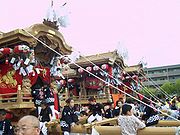
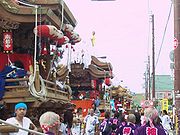
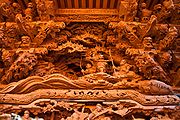
s (danjiri guruma) in the shape of a shrine
or temple
. The carts, often being crafted out of wood, are very ornate, with elaborate carvings. Towns with danjiri festivals in them have different neighborhoods, each with their own guild
responsible for maintaining their own danjiri cart. The cart is kept in storage for most of the year. As the festival approaches, the danjiri cart is prepared with elaborate flower arrangements, prayer
cards, ornaments, and religious consecrations. It is believed that spirits
or gods reside in the danjiri.
for the big event, and they are decorated in various ways. For decorations, flag
s, prayer cards, fresh flower arrangements, and in some cases even lanterns are used. The taiko
("drum") and Kane
("bell") used to play the town danjiri rhythm
are loaded onto the cart, and the musician
s selected to ride the danjiri practice for months in advance. The ages of the selected musicians can vary from old veterans of the festival to child
ren as young as four years of age.
coat and head-band. The event is accompanied with the commotion of the participants pulling the cart, as they yell their kakegoe
or signature shout, equivalent to the English "heave-ho!" Adding to the atmosphere is the danjiri rhythm played on drums and bells throughout the cart pulling, which can be heard from street blocks away. In towns with many guilds, the danjiri matsuri consists of various danjiri crisscrossing the streets at the same time. The festival usually ends in the danjiri gathering at an appointed place and having a religious ceremony.
of Kishiwada every year. It is common for danjiri to hit and damage buildings when they careen around a corner, and for this reason shop owners may buy Danjiri Insurance. The Kishiwada Danjiri Matsuri
is probably the most famous Danjiri festival, with its fast danjiri and very animated guild leaders that ride up on top of the danjiri, hopping and dancing
as the danjiri moves faster and faster. It attracts thousands of spectators every year.
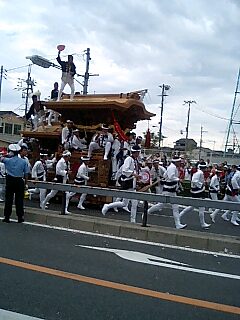
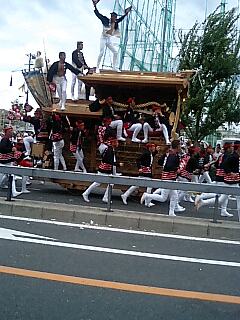
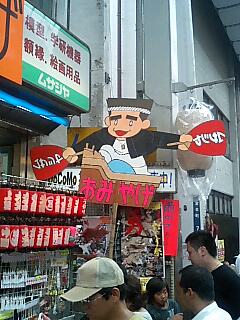
Japan
Japan is an island nation in East Asia. Located in the Pacific Ocean, it lies to the east of the Sea of Japan, China, North Korea, South Korea and Russia, stretching from the Sea of Okhotsk in the north to the East China Sea and Taiwan in the south...
. The Kishiwada Danjiri Matsuri
Kishiwada Danjiri Matsuri
The , held in Kishiwada, Osaka, is one of the most famous Danjiri Matsuri in Japan.-History:The festival began in 1703 when the Daimyo of Kishiwada, Okabe Nagayasu , prayed to Shinto gods for an abundant harvest at Fushimi Inari-taisha, Kyoto.-Summary:...
is probably the most famous.



The danjiri cart
Danjiri are large wooden cartCart
A cart is a vehicle designed for transport, using two wheels and normally pulled by one or a pair of draught animals. A handcart is pulled or pushed by one or more people...
s (danjiri guruma) in the shape of a shrine
Shrine
A shrine is a holy or sacred place, which is dedicated to a specific deity, ancestor, hero, martyr, saint, daemon or similar figure of awe and respect, at which they are venerated or worshipped. Shrines often contain idols, relics, or other such objects associated with the figure being venerated....
or temple
Temple
A temple is a structure reserved for religious or spiritual activities, such as prayer and sacrifice, or analogous rites. A templum constituted a sacred precinct as defined by a priest, or augur. It has the same root as the word "template," a plan in preparation of the building that was marked out...
. The carts, often being crafted out of wood, are very ornate, with elaborate carvings. Towns with danjiri festivals in them have different neighborhoods, each with their own guild
Guild
A guild is an association of craftsmen in a particular trade. The earliest types of guild were formed as confraternities of workers. They were organized in a manner something between a trade union, a cartel, and a secret society...
responsible for maintaining their own danjiri cart. The cart is kept in storage for most of the year. As the festival approaches, the danjiri cart is prepared with elaborate flower arrangements, prayer
Prayer
Prayer is a form of religious practice that seeks to activate a volitional rapport to a deity through deliberate practice. Prayer may be either individual or communal and take place in public or in private. It may involve the use of words or song. When language is used, prayer may take the form of...
cards, ornaments, and religious consecrations. It is believed that spirits
Kami
is the Japanese word for the spirits, natural forces, or essence in the Shinto faith. Although the word is sometimes translated as "god" or "deity", some Shinto scholars argue that such a translation can cause a misunderstanding of the term...
or gods reside in the danjiri.
Festival preparation
Town guild members spend a considerable amount of time to prepare for the festival. Meetings and consecrations are held at shrines days before the festival. The carts themselves must be readied for pulling, as they are stored partly disassembled in warehouses. The carts are consecratedConsecration
Consecration is the solemn dedication to a special purpose or service, usually religious. The word "consecration" literally means "to associate with the sacred". Persons, places, or things can be consecrated, and the term is used in various ways by different groups...
for the big event, and they are decorated in various ways. For decorations, flag
Flag
A flag is a piece of fabric with a distinctive design that is usually rectangular and used as a symbol, as a signaling device, or decoration. The term flag is also used to refer to the graphic design employed by a flag, or to its depiction in another medium.The first flags were used to assist...
s, prayer cards, fresh flower arrangements, and in some cases even lanterns are used. The taiko
Taiko
means "drum" in Japanese . Outside Japan, the word is often used to refer to any of the various Japanese drums and to the relatively recent art-form of ensemble taiko drumming...
("drum") and Kane
Kane (musical instrument)
The is a type of bell from Japan.Often accompanying Japanese folk music, or Min'yō, is a dish-shaped bell called a . It is often hung on a bar, and the player holds the bell in place with one hand, and beats the Kane with a specialized mallet with the other...
("bell") used to play the town danjiri rhythm
Rhythm
Rhythm may be generally defined as a "movement marked by the regulated succession of strong and weak elements, or of opposite or different conditions." This general meaning of regular recurrence or pattern in time may be applied to a wide variety of cyclical natural phenomena having a periodicity or...
are loaded onto the cart, and the musician
Musician
A musician is an artist who plays a musical instrument. It may or may not be the person's profession. Musicians can be classified by their roles in performing music and writing music.Also....* A person who makes music a profession....
s selected to ride the danjiri practice for months in advance. The ages of the selected musicians can vary from old veterans of the festival to child
Child
Biologically, a child is generally a human between the stages of birth and puberty. Some vernacular definitions of a child include the fetus, as being an unborn child. The legal definition of "child" generally refers to a minor, otherwise known as a person younger than the age of majority...
ren as young as four years of age.
The festival
The days of the festival vary from year to year and from town to town, although it is usually held in autumn, in late September or October. On the day(s) of the festival, members of the town guilds pull their danjiri through the streets of the town, wearing their guild happiHappi
Happi is a traditional Japanese straight-sleeved coat usually made of indigo or brown cotton and imprinted with a distinctive mon . They are usually worn only to festivals. Originally, these represented the crest of a family, as happi were worn by house servants. Later, the coats commonly began to...
coat and head-band. The event is accompanied with the commotion of the participants pulling the cart, as they yell their kakegoe
Kakegoe
Kakegoe can be literally translated as "hung voice" or "a voice you hang." The "hanging" part is probably meant to be taken in an abstract sense to mean "ornament" or "decoration," as it is the same Japanese verb used when talk about kakemono. Kakegoe, therefore, refers to an auxiliary pitched or...
or signature shout, equivalent to the English "heave-ho!" Adding to the atmosphere is the danjiri rhythm played on drums and bells throughout the cart pulling, which can be heard from street blocks away. In towns with many guilds, the danjiri matsuri consists of various danjiri crisscrossing the streets at the same time. The festival usually ends in the danjiri gathering at an appointed place and having a religious ceremony.
Variations
The way in which the festivals are celebrated vary from town to town. The danjiri carts can vary in size and decorative style. Some are large and tall, others are relatively small. In some towns, the danjiri are pulled slowly through the town until they get to their destination. In other towns, the danjiri are pulled as fast as the people can pull it. This results in a difficulty turning the cart at corners, sometimes resulting in the cart falling over and killing someone. It is said that at least one person dies in the danjiri festivalFestival
A festival or gala is an event, usually and ordinarily staged by a local community, which centers on and celebrates some unique aspect of that community and the Festival....
of Kishiwada every year. It is common for danjiri to hit and damage buildings when they careen around a corner, and for this reason shop owners may buy Danjiri Insurance. The Kishiwada Danjiri Matsuri
Kishiwada Danjiri Matsuri
The , held in Kishiwada, Osaka, is one of the most famous Danjiri Matsuri in Japan.-History:The festival began in 1703 when the Daimyo of Kishiwada, Okabe Nagayasu , prayed to Shinto gods for an abundant harvest at Fushimi Inari-taisha, Kyoto.-Summary:...
is probably the most famous Danjiri festival, with its fast danjiri and very animated guild leaders that ride up on top of the danjiri, hopping and dancing
Dance
Dance is an art form that generally refers to movement of the body, usually rhythmic and to music, used as a form of expression, social interaction or presented in a spiritual or performance setting....
as the danjiri moves faster and faster. It attracts thousands of spectators every year.




